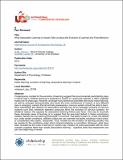Files in this item
What associative learning in insects tells us about the evolution of learning and fixed behavior
Item metadata
| dc.contributor.author | Hollis, Karen | |
| dc.contributor.author | Guillette, Lauren | |
| dc.date.accessioned | 2015-07-31T10:40:02Z | |
| dc.date.available | 2015-07-31T10:40:02Z | |
| dc.date.issued | 2015 | |
| dc.identifier | 205996395 | |
| dc.identifier | b9d4fc8d-78b4-440d-8bbe-76000a5d4bc6 | |
| dc.identifier.citation | Hollis , K & Guillette , L 2015 , ' What associative learning in insects tells us about the evolution of learning and fixed behavior ' , International Journal of Comparative Psychology , vol. 28 . | en |
| dc.identifier.uri | https://hdl.handle.net/10023/7086 | |
| dc.description.abstract | Contemporary models for the evolution of learning suggest that environmental predictability plays a critical role in whether learning is expected to evolve in a particular species, a claim originally made over 50 years ago. However, amongst many behavioral scientists who study insect learning, as well as amongst neuroscientists who study the brain architecture of insects, a very different view is emerging, namely that all animals possessing a nervous system should be able to learn. More specifically, the capacity for associative learning may be an emergent property of nervous systems such that, whenever selection pressures favor the evolution of nervous systems, for whatever reason, the capacity for associative learning follows ipso facto. One way to reconcile these disparate views of learning is to suggest that the assumed default in these evolutionary models, namely the non-learning phenotype, is incorrect: The ability to learn is, in fact, the default but, under certain conditions, selection pressures can override that ability, resulting in hard-wired, or considerably less plastic, responses. Thus, models for the evolution of learning actually may be models for the conditions under which inherent plasticity is overridden. Moreover, what have been revealed as the costs of learning in insects may, instead, be costs associated with far more complex cognitive feats than simple associative learning – cognitive skills that researchers are just now beginning to reveal. | |
| dc.format.extent | 19 | |
| dc.format.extent | 1976285 | |
| dc.language.iso | eng | |
| dc.relation.ispartof | International Journal of Comparative Psychology | en |
| dc.subject | Insect learning | en |
| dc.subject | Evolution of learning | en |
| dc.subject | Associative learning in insects | en |
| dc.subject | QH301 Biology | en |
| dc.subject.lcc | QH301 | en |
| dc.title | What associative learning in insects tells us about the evolution of learning and fixed behavior | en |
| dc.type | Journal article | en |
| dc.contributor.institution | University of St Andrews. School of Biology | en |
| dc.contributor.institution | University of St Andrews. Centre for Social Learning & Cognitive Evolution | en |
| dc.description.status | Peer reviewed | en |
| dc.identifier.url | http://escholarship.org/uc/item/3v15313t Author | en |
This item appears in the following Collection(s)
Items in the St Andrews Research Repository are protected by copyright, with all rights reserved, unless otherwise indicated.

